This
picture gallery summarizes the invertebrates found in tidepools at Playa
Estacion, Puerto Penasco, Sonora, Mexico.
It should
be used to complete lab activity 9.3.
|
Tedania
nigrescens
|
 |
"Fire
sponge"
| Phylum |
Porifera |
| Class |
Demospongiae |
| Order |
Poecilosclerida |
| Family |
Tedaniidae |
|
| Morphology |
A
bright red to orange sponge which may or may not have visible
excurrent pores (oscula). Varies from encrusting to massive. |
| Feeding |
Filter feeding |
| Defense |
Unpalatable |
| Reproduction |
Spawning |
| Habitat |
On rocks in
the lower intertidal and subtidal |
| Distribution |
Throughout the
Gulf of California to Ecuador |
| Other |
Handling this
sponge may iritate the skin |
|
|
Haliclona
permollis
|
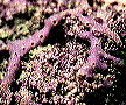 |
"Wandering
sponge"
| Phylum |
Porifera |
| Class |
Demospongiae |
| Order |
Haplosclerida |
| Family |
Haliclonidae |
|
| Morphology |
A
soft, pale rose to vivid purple sponge with regularly spaced
excurrent pores (oscula). Forms flat sheets or meandering strands. |
| Feeding |
Filter feeding |
| Defense |
Unpalatable |
| Reproduction |
Asexual budding
and sexual spawning |
| Habitat |
Rocky shores |
| Distribution |
Throughout the
world's oceans including the Gulf of California |
| Other |
|
|
|
Aglaophenia
diegensis
|
 |
"Ostrich
plume hydroid"
| Phylum |
Cnidaria |
| Class |
Hydrozoa |
| Order |
Hydroida |
| Family |
Plumulariidae |
|
| Morphology |
Delicate
yellowish-tan to brown feather-like plume that grows singly
or in small clumps. Each plume has a center ridge to which a
few small seed-shaped reproductive bodies are attached. Grows
tall to 150 mm. |
| Feeding |
All polyps share
a common hollow gut for digestion. |
| Defense |
Has stinging
cells that when touched, are irritating. |
| Reproduction |
The thickened
parts on the individual stalk indicate mature gonozoids which
repture and release medusae into the ocean. When the medusae
reproduce, the larvae settle to the bottom, attach and become
ostrich plumes again. |
| Habitat |
Growing around
the edge of a tidepool attached to rocks, shells, ledges, and
pilings. |
| Distribution |
Alaska to Ecuador
and throughout the Gulf of California |
| Other |
Most common
intertidal hydroid of the Gulf of California |
|
|
Bunodosoma
californica
|
 |
"Warty
anemone"
| Phylum |
Cnidaria |
| Class |
Anthozoa |
| Order |
Actiniaria |
| Family |
Actiniidae |
|
| Morphology |
Large
and solitary. Brownish-red or orange - tenacles may be red,
brown or green. Its column is covered with bumps or warts randomly
placed. |
| Feeding |
Paralyzes its
prey with stinging cells in their tentacles. |
| Defense |
Can release
stinging cells (nematocysts) and will retract when touched. |
| Reproduction |
Spawning |
| Habitat |
Rocky intertidal
areas. |
| Distribution |
Gulf of California,
Baja ranging to Bahia Magdalena. |
| Other |
Perhaps the
most abundant large anemone found in the gulf. |
|
|
Phyllactis
cocinnata
|
 |
"Pink
sand anemone"
| Phylum |
Cnidaria |
| Class |
Anthozoa |
| Order |
Actiniaria |
| Family |
Phyllactidae |
|
| Morphology |
The
oral surface of this anemone has a circle of short true tentacles
surrounded by a ruff or collar resembling a circle of short,
fused tentacles. It has a pink or white column which is usually
buried in the sand. It has a large pedal disc which is generally
attached to a buried rock. |
| Feeding |
Paralyzes its
prey with stinging cells in their tentacles. |
| Defense |
Can release
stinging cells (nematocysts) and it can withdraw folding its
ruff inward. The bottom of the ruff is covered by adhering sand. |
| Reproduction |
Spawning |
| Habitat |
In cracks and
crevices of tidepools on rocky shores where sand is abundant. |
| Distribution |
Throughout the
Gulf of California |
| Other |
|
|
|
Palythoa
ignota
|
|
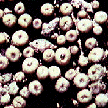
|
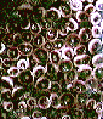 |
"Mat
anemone"
| Phylum |
Cnidaria |
| Class |
Anthozoa |
| Order |
Zoanthidea |
| Family |
|
|
|
| Morphology |
Small
colonial anemone with very short tentacles on margin of oral
disk. They are brownish, with a tinge of green in the mouth
area because of tiny algae living there. Mat forming. |
| Feeding |
Paralyzes its
prey with stinging cells (nematocysts). Expands at night to
feed. |
| Defense |
Stinging cells
are used for defense as well as feeding |
| Reproduction |
Sexual spawning
to found new colonies and sexual budding to form new members
of the colony |
| Habitat |
On rocks in
the low intertidal and subtidal, permanent tidepools, and drainage
channels. |
| Distribution |
Northern Gulf
of California. |
| Other |
Forms a solid
carpet on the reefs in the low intertidal. |
|
|
Zoanthus
danae
|
 |
"Green
mat anemone"
| Phylum |
Cnidaria |
| Class |
Anthozoa |
| Order |
Zoanthidea |
| Family |
|
|
| Morphology |
Tiny
colonial anemone with thinly set individuals. Forms a solid
carpet on the reefs in the low intertidal. They are bright green
because of tiny algae living in their flesh. |
| Feeding |
Gets food from
microscopic, symbiotic algae living inside it. Can also paralyzes
prey with stinging cells (nematocysts). |
| Defense |
Stinging cells
are used for defense as well as feeding |
| Reproduction |
Sexual spawning
to found new colonies and sexual budding to form new members
of the colony |
| Habitat |
On rocks and
on the sponge Geodia in the lower intertidal. |
| Distribution |
Gulf of California
south to Panama |
| Other |
|
|
|
Porites
californica
|
|

|
 |
"Green
coral"
| Phylum |
Cnidaria |
| Class |
Anthozoa |
| Order |
Madreporaria |
| Family |
Poritidae |
|
|
| Morphology |
This
stony coral forms a thick crust or columnar-like growth on rocks.
The live colony is a bright green and the underlining dead skeletal
mass is white. Five to seven inch colonies are scattered and
do not form reefs. |
| Feeding |
Gets food from
microscopic, symbiotic algae living inside it. Can also paralyzes
prey with stinging cells (nematocysts). |
| Defense |
Stinging cells
are used for defense as well as feeding |
| Reproduction |
Sexual spawning
to found new colonies and sexual budding to form new members
of the colony |
| Habitat |
On rocks in
the intertidal and shallow subtidal |
| Distribution |
Throughout the
Gulf of California south to Panama |
| Other |
|
|
|
Lophogorgia
rigida
|
 |
"Purple
gorgonian"
| Phylum |
Cnidaria |
| Class |
Anthozoa |
| Order |
Gorgonacea |
| Family |
Gorgoniidae |
|
| Morphology |
Purple,
branched, soft coral. Branching mostly in one plane to form
a fan shaped colony. Branches bear, small, white polyps (individuals
of the colony). |
| Feeding |
Carnivorous
on zooplankton |
| Defense |
Stinging cells
are used for defense as well as feeding |
| Reproduction |
Sexual spawning
to found new colonies and sexual budding to form new members
of the colony |
| Habitat |
Rocky subtidal
reefs and lower intertidal tidepools |
| Distribution |
|
| Other |
|
|
|
Megalomma
splendida
|
 |
"Orange
feather duster worm"
| Phylum |
Anellida |
| Class |
Polychaeta |
| Order |
Sedentaria |
| Family |
Sabellidae |
|
| Morphology |
Slender
segmented worm about 2 inches long with a feathery crown that
varies in color from orange to purple. Lives in a coarsely textured
tube of sand grains and mucus cement. |
| Feeding |
Filter feeding
using their ciliated feathery crowns. |
| Defense |
Expose only
their feeding crowns which they can retract rapidly into their
tubes. |
| Reproduction |
Separte sexes.
Females produce egg masses during the summer that are brooded
inside their tubes. |
| Habitat |
Rocky shore
tidepools and shallow subtidal |
| Distribution |
California,
throughout the Gulf of California and south along the Mexican
coast |
| Other |
|
|
|
Paguristes
anahuacus
|
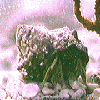 |
"Blue-eyed
hermit crab"
| Phylum |
Arthropoda |
| Class |
Crustacea |
| Order |
Decapoda |
| Family |
Diogenidae |
|
| Morphology |
Cream
colored hermit crab with hairy, equal sized claws, and blue
tipped antennae. Young have blue eyes. |
| Feeding |
Filter feeders
and scavengers |
| Defense |
Occupies the
shell of a dead snail |
| Reproduction |
Separate sexes.
Females brood eggs on pleopods until they hatch. |
| Habitat |
Under boulders
and on the surfaces of rocky shores in the lower intertidal,
in tidepools and in the shallow subtidal |
| Distribution |
Gulf of California |
| Other |
Second most
abundant rocky shore hermit crab in the Gulf of California.
Gregarious. |
|
|
Alpheus
californiensis
|
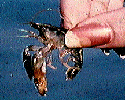 |
"Snapping
shrimp"
| Phylum |
Arthropoda |
| Class |
Crustacea |
| Order |
Decapoda |
| Family |
Alpheidae |
|
| Morphology |
Colorful,
fast, backwards swimming shrimp that are easily identified by
their one large claw that is modified for making loud clicking
or popping noises. |
| Feeding |
Snap large claw
to stun prey. Use claw to grab small animals or morsels of food
floating by. |
| Defense |
Hard shell on
body (after molting, the body is soft. The shell hardens after
a few hours, however, during that time they are vulnerable). |
| Reproduction |
Separate sexes.
Females brood eggs on pleopods until they hatch. |
| Habitat |
Lives in tunnels
under rocks in a sandy substrate. |
| Distribution |
Southern California
to the Gulf of California, common at Puerto Penasco |
| Other |
If large claw
is pulled off the other hand will develop a large claw. |
|
|
Epialtus
minimus
|
 |
"Sargassum
spider crab"
| Phylum |
Arthropoda |
| Class |
Crustacea |
| Order |
Decapoda |
| Family |
Majidae |
|
| Morphology |
Small
majid crab with an elongated, flattened and bifurcate rostrum
in the males but a shorter, rounded and more truncate rostrum
in females. Dorsal surface is reddish-yellow, occasionally spotted
with brown. |
| Feeding |
|
| Defense |
Cryptic coloration
and shape matches the Sargassum they live on. |
| Reproduction |
Separate sexes.
Females brood eggs on pleopods until they hatch. |
| Habitat |
Commomly found
clinging to bunches of Sargassum especially where this
seaweed forms large beds or mats. |
| Distribution |
Lajuna Ojo de
Liebre (Scammon's Lagoon) and throughout the Gulf of California,
south at least as far as Acapulco. |
| Other |
|
|
|














